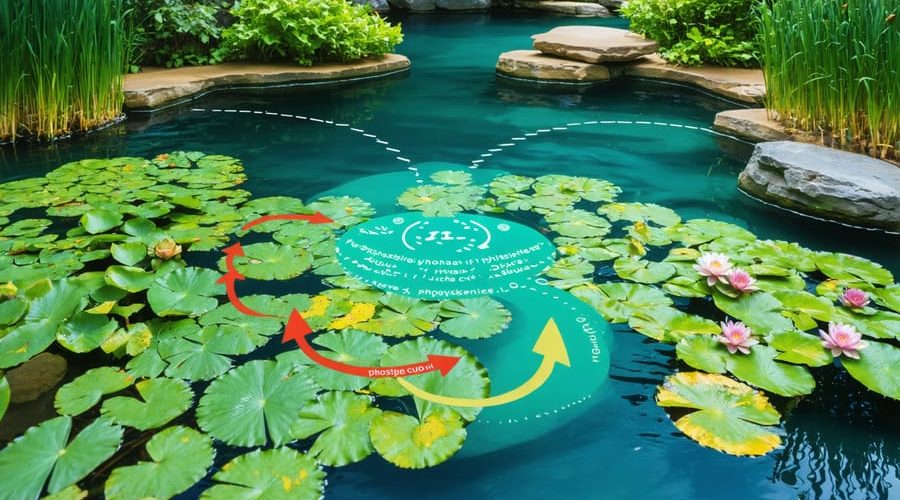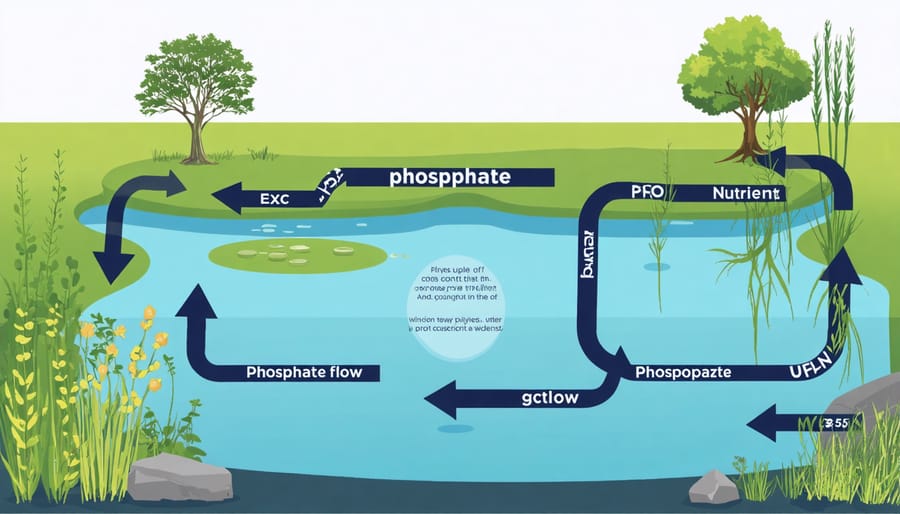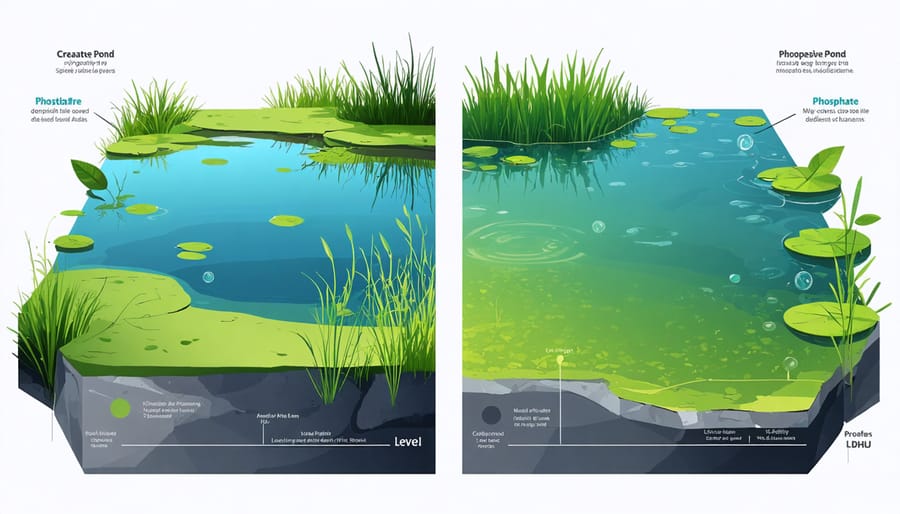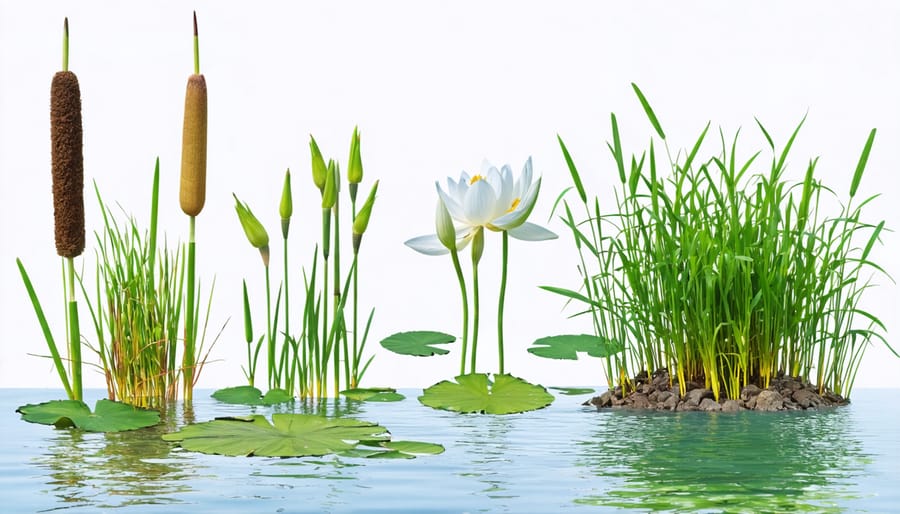
Keep Your Pond Crystal Clear: How Phosphates Make or Break Your Water Garden
Phosphates flow through our ponds and water gardens in a fascinating dance of life, death, and renewal. As vital as they are potentially problematic, these essential nutrients power the growth of every aquatic plant while simultaneously posing risks of algae blooms when levels spiral out of control. Whether you’re a seasoned pond keeper or just starting your water gardening journey, understanding the phosphate cycle is key to maintaining crystal-clear waters and healthy aquatic ecosystems.
In nature, phosphates move through a perfectly balanced cycle – from rocks and soil into living organisms, then back again through decomposition. But in our backyard ponds, this delicate balance can easily tip toward excess, leading to murky waters and struggling fish. The good news? By working with nature’s own processes, you can maintain ideal phosphate levels without harsh chemicals or complicated equipment.
Let’s dive into the practical ways you can harness the phosphate cycle to create a thriving, self-sustaining pond ecosystem that practically maintains itself. Whether you’re battling an algae outbreak or simply want to prevent future problems, understanding this crucial nutrient cycle is your first step toward pond-keeping success.
Understanding the Phosphate Cycle in Your Pond
Natural Sources of Phosphates
In nature, phosphates come from several fascinating sources that contribute to your pond’s ecosystem. Fish waste is one of the most common sources – as your finned friends digest their food, they release phosphates into the water. This process is completely natural and happens in every healthy pond.
Decaying plant matter is another significant contributor. When leaves, stems, and other plant materials break down, they release phosphates back into the water. This is especially noticeable during autumn when falling leaves collect in your pond, or when aquatic plants naturally die back.
Runoff from surrounding areas can also bring phosphates into your pond. Rain washes nutrients from nearby soil, lawns, and gardens straight into your water feature. If you use fertilizers in your garden, these can significantly increase phosphate levels through runoff. Natural soil erosion also contributes phosphates, particularly after heavy rainfall.
Wildlife visitors like birds and amphibians add their own share of phosphates through their droppings. While this might seem problematic, remember that these natural sources of phosphates are part of a healthy pond ecosystem – it’s all about maintaining the right balance.

The Role of Beneficial Bacteria
Beneficial bacteria are the unsung heroes of your pond’s phosphate cycle, working tirelessly to break down waste and maintain healthy water conditions. These microscopic workhorses transform harmful phosphates into forms that plants can readily use, creating a natural filtration system within your pond.
Think of these bacteria as your pond’s cleanup crew. They colonize your filter media, rocks, and plant roots, forming invisible but essential biofilms. When fish waste, uneaten food, and deceased plant matter sink to the bottom, these bacteria spring into action. They break down complex organic materials, converting phosphates into simpler compounds that aquatic plants can absorb.
What’s fascinating is that different types of beneficial bacteria work together in stages. Some specialize in breaking down solid waste, while others focus on converting dissolved phosphates. This teamwork creates a natural cycle that helps prevent algae blooms and maintains crystal-clear water.
To support these helpful bacteria, maintain good oxygen levels in your pond and avoid harsh chemical treatments that might harm their populations. A healthy bacterial colony is your best ally in managing phosphate levels naturally.

Signs of Phosphate Problems
Visible Warning Signs
When your pond’s phosphate cycle becomes unbalanced, several signs of nutrient overload become apparent. The most noticeable is the sudden appearance of algae blooms, which can turn your crystal-clear pond into a murky green soup within days. These blooms often form a thick, floating mat on the surface, blocking sunlight from reaching deeper waters.
Water clarity issues are another red flag – if you can’t see more than 12-18 inches into your pond, there might be a phosphate problem. Your pond water might take on a cloudy, tea-like appearance, or develop an unpleasant odor.
Watch your aquatic plants closely too. While some growth is healthy, excessive phosphates can cause plants to grow too quickly, becoming leggy and weak. You might notice your water lilies producing more leaves than usual but fewer flowers. Submerged plants may become covered in a slimy coating, and some might even start dying off despite seemingly favorable conditions. These visible symptoms are your pond’s way of telling you it needs attention!
Testing Your Pond’s Phosphate Levels
Regular monitoring of your pond’s phosphate levels is essential for maintaining a healthy aquatic environment. The most reliable method is using a phosphate test kit, which you can find at most pond supply stores. These kits typically come with clear instructions and color charts that make testing water chemistry straightforward, even for beginners.
To test your pond’s phosphate levels, collect a water sample from about 18 inches below the surface, away from any fountains or waterfalls. Fill the test tube to the indicated line and add the required testing solutions according to the kit’s instructions. After waiting for the specified time (usually 3-5 minutes), compare the water’s color to the provided chart.
Ideal phosphate levels should be below 0.5 parts per million (ppm). Test your pond water at least once a month during the growing season and after heavy rainfall. If you notice any sudden algae growth or changes in water clarity, it’s wise to test more frequently. Keep a simple log of your readings to track changes over time and identify patterns that might affect your pond’s health.
Natural Phosphate Control Methods
Beneficial Plants That Absorb Phosphates
Several aquatic plants excel at absorbing excess phosphates from pond water, making them perfect natural filters and natural algae control methods. Water hyacinths are particularly effective, with their extensive root systems that act like tiny filters. These floating plants are easy to maintain and multiply quickly, though you’ll need to regularly remove excess growth to prevent overcrowding.
Cattails are another fantastic option for phosphate absorption. These familiar pond plants don’t just look attractive; their robust root systems work tirelessly to clean your water. Plant them in shallow areas or along the pond’s edge for best results.
Water iris adds both beauty and function to your pond. Their striking flowers bring color to your water garden while their roots help maintain healthy phosphate levels. Consider adding rushes and sedges too – these hardy plants thrive in wet conditions and are excellent at nutrient uptake.
Duckweed, though tiny, packs a powerful punch in phosphate removal. This floating plant reproduces rapidly and can cover your pond’s surface, so you’ll want to keep it in check. Remember to harvest these plants periodically – this removes the absorbed phosphates permanently from your pond system and prevents them from being released back into the water when the plants decompose.

Creating a Balanced Ecosystem
Creating a balanced phosphate ecosystem in your pond doesn’t have to be complicated. The key to maintaining ecosystem balance lies in following nature’s lead. Start by introducing a variety of aquatic plants, which naturally absorb excess phosphates. Water lilies, cattails, and floating plants like duckweed are excellent choices for this purpose.
Regular maintenance is crucial but doesn’t need to be overwhelming. Remove fallen leaves and debris before they decompose, as these release phosphates into the water. Consider creating a small wetland area at one end of your pond using gravel and beneficial bacteria – this acts as a natural filtration system.
Feed fish moderately, as uneaten food contributes to phosphate buildup. A good rule of thumb is to offer only what they can consume within five minutes. Installing a bottom drain or using a pond vacuum helps remove settled organic matter before it breaks down and releases phosphates.
Monitor your pond’s phosphate levels monthly using simple test kits available at garden centers. If levels start creeping up, increase plant coverage or add beneficial bacteria. Remember, a healthy pond is all about balance – not elimination. Some phosphates are necessary for plant growth, so aim for moderation rather than complete removal.
For long-term success, work with your pond’s natural cycles rather than against them. This approach creates a self-sustaining system that requires less intervention over time.
Direct Intervention Strategies
Physical Removal Methods
Physical removal methods are among the most straightforward ways to manage phosphate levels in your pond. The process starts with regular skimming to remove floating debris like leaves, twigs, and dead plant material before they sink and decompose. This simple yet effective practice prevents these organic materials from breaking down and releasing more phosphates into the water.
A pond net or skimmer basket is your best friend in this task – aim to skim the surface at least once a week, more frequently during fall when leaves are falling. For sunken debris, a pond vacuum can work wonders in removing settled organic matter from the bottom. Think of it as underwater housekeeping!
Installing mechanical filtration systems adds another layer of defense. Bottom drains and surface skimmers continuously collect debris before it can decompose. These systems work particularly well when combined with filter mats or screens that trap smaller particles. For the best results, clean your filters regularly – about once every two weeks during peak growing season.
Don’t forget about excess plant matter! Regularly trim aquatic plants and remove dead portions before they decay. This not only keeps your pond looking tidy but also significantly reduces the amount of organic material that could potentially release phosphates into the water. As a bonus, your fish will thank you for the clearer swimming space!
Chemical Solutions and When to Use Them
When your pond’s phosphate levels become problematic, chemical solutions can be a quick and effective fix – but it’s important to use them correctly. The most common phosphate removers contain lanthanum or aluminum-based compounds that bind with phosphates, making them inactive and allowing for easy removal through filtration.
Before using any chemical treatment, always test your pond water to confirm high phosphate levels. The ideal time to use phosphate removers is during early spring or when tests show levels above 0.5 parts per million (ppm). Start with a half-dose and monitor your pond’s response over 24-48 hours before adding more if needed.
While using chemical treatments, keep your pond’s filtration system running to help remove the bound phosphates. It’s also wise to maintain good water circulation and aeration during treatment. Some treatments may temporarily cloud the water – this is normal and usually clears within a day.
Remember that chemical solutions are temporary fixes. For long-term success, combine treatments with natural phosphate control methods like regular maintenance, proper fish feeding, and using phosphate-absorbing plants. Always read product labels carefully and wear protective gear when handling chemicals. If you’re unsure about dosage, it’s better to start conservative and adjust as needed.
Be cautious with chemical treatments in ponds containing sensitive species or during spawning periods. When in doubt, consult with a pond specialist about the best treatment options for your specific situation.
Preventive Maintenance
Maintaining healthy phosphate levels in your pond is much easier when you develop a consistent maintenance routine. Start by establishing a regular cleaning schedule to remove fallen leaves, dead plants, and other organic debris before they can break down and release phosphates into the water. Installing a pond skimmer or net cover can significantly reduce this maintenance burden.
Consider creating a buffer zone of beneficial plants around your pond’s edge. These plants act as natural filters, absorbing excess nutrients before they enter the water. Water iris, cattails, and rushes are excellent choices that not only help manage phosphate levels but also add visual appeal to your pond.
Regular water testing is crucial for long-term phosphate management. Set a monthly schedule for testing and keep a log of your results. This helps you spot trends and address issues before they become problems. Many pond owners find that spring and fall require more frequent testing due to changing environmental conditions.
Proper fish stocking is another key preventive measure. Overstocking leads to excessive waste production and higher phosphate levels. A good rule of thumb is to maintain no more than one inch of fish per ten gallons of water. Feed your fish only what they can consume in five minutes to prevent excess food from decomposing in the water.
Finally, consider implementing a regular partial water change schedule, replacing about 10-15% of pond water monthly. This helps maintain stable phosphate levels while preserving beneficial bacteria and maintaining ecosystem balance. Remember that prevention is always easier than correction when it comes to phosphate management.
Understanding and maintaining the phosphate cycle in your pond is crucial for a thriving aquatic ecosystem. We’ve explored how phosphates enter your pond, their impact on plant and algae growth, and various methods to keep them in check. Remember that a healthy phosphate cycle is all about balance – too little can limit plant growth, while too much can lead to algae problems.
Regular testing is your best friend in pond maintenance. Make it a habit to check phosphate levels at least monthly, and more frequently during warm seasons or after heavy rains. Keep a simple log of your readings to track patterns and spot potential issues before they become problems.
By combining natural solutions like proper plant selection, beneficial bacteria, and routine maintenance, you can maintain optimal phosphate levels without relying heavily on chemical treatments. Don’t forget that every pond is unique, so what works for one might need adjusting for another.
Stay observant of your pond’s behavior, and don’t hesitate to make small adjustments to your maintenance routine as needed. With consistent monitoring and care, you’ll be rewarded with a beautiful, balanced pond ecosystem that brings joy year after year.
